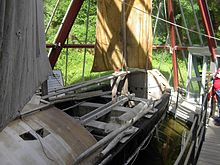Craggaunowen
Craggaunowen ( Irish : Creagán Eoghain ) is a small village near Kilmurry, near Quin , about 16 km east of Ennis , in County Clare in Ireland . Here are some scattered farms around an old castle and the Craggaunowen Megalithic Center .
Craggaunowen Megalithic Center
The Center is an attempt to bring Ireland's past to life. For this purpose, huts , hunting stations, a portal tomb and a pile building from prehistoric times and around the castle Craggaunowen Castle were reconstructed. In addition to a number of lakes there is a restored crannóg . This is how an open air museum was created .
The idea came from John Hunt († 1976), an art-historical advisor to the auction house Sotheby’s , who was well versed in the history of the European Middle Ages. He bought the land at Craggaunowen, restored the castle and started building a museum, the core of which is a crannóg and a ring fort .
Craggaunowen Castle
The castle was built around 1550 by John MacSioda MacNamara and is a classic residential tower , the usual home of the landed gentry at the time . After the collapse of the old social system due to its defeat by Oliver Cromwell's troops in 1649–52, the castle was abandoned in the 17th century and fell into disrepair.
The restoration began in the early 19th century under the direction of Tom Steele. The work was not completed until 1965 by the antique collector John Hunt, who also arranged the extension on the ground floor.
The pile dwelling
Crannógs are artificial islands in the flat area of lakes or in marshland or on natural islands, on which the people of the Iron Age built huts into the early Christian period, the real purpose of which is probably in the cultic area. Some of them already existed in the Bronze Age and some were used and inhabited until the 17th century. This crannóg is the reconstruction of a stilt house that did not exist on site, as was particularly common in the north-west of Ireland. Crannógs can also be found in Scotland, where they are associated with the Picts .
The construction
The foundation was formed by several layers of stones and bushes that were sunk in the lake. The whole thing found its support with wooden stakes rammed into the ground in a circle , which delimit the platform filled with earth and sand. The builders built huts made of wickerwork and clay within a palisade fence . A number of Crannógs are within sight of other ancient structures, such as megalithic systems.
One could reach the artificial islands in the shallow water on foot, by dugout canoe or over dams and footbridges, which excludes that they were used for defense.
The ring fort
In Ireland there are almost 40,000 ring forts on 84,425 km², which are also known locally as Dun or Rath . This design from pre-Christian times also reached the west of Scotland.
Within the palisade, the residents did not go about their everyday activities. These facilities can only be explained as forerunners of the Christian monasteries. Their number is so great because they went out of use after a certain period of time and were often replaced by successors in the immediate vicinity.
Such a so-called ring fort was the center of local social life at that time.
The "Brendan"
Probably the most speculative property of the entire complex is certainly the "Brendan" , a curragh named after St. Brendan in which Timothy Severin sailed from Ireland to North America in 1976 .
In a manuscript with the title “ Navigatio Sancti Brendani Abbatis ” it is described that St. Brandan discovered the land on the other side of the Atlantic on a journey from the Emerald Isle. However, the representation is scientifically questioned. Severin wanted to prove that this was not a fiction from the 9th century and had a leather boat built, which with its ash wood frame could allegedly even defy the drift ice . With stopovers in the Aran Islands , the Hebrides and the Faroe Islands , he came to Iceland , where he spent the winter. In June 1977 he reached Canada , proving that there was at least the possibility of reaching the North American continent in this way .
Hunt later gave the complex to the Irish people.
See also
literature
- Claus Ahrens: Reconstructed prehistoric times - Archaeological open-air museums in Europe . Wachholtz, Neumünster 1990, ISBN 3-529-01838-4 .
Web links
Coordinates: 52 ° 48 ′ 42.9 " N , 8 ° 47 ′ 43" W.






